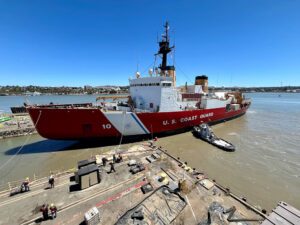
U.S. Coast Guard cutter Healy arrived in Seattle on Aug. 16 after a research mission in the Pacific sector of the Arctic Ocean in support of the Arctic Observing Network initiative, funded by the U.S. National Science Foundation.
The Healy’s crew and embarked researchers worked on more than 150 conductivity, temperature and depth (CTD) casts to investigate the circulation and properties of the water, monitored for signs of harmful algal blooms and collected observations on marine mammals and birds in the Bering, Chukchi and Beaufort Seas, according to the Coast Guard.
Additionally, two subsurface moorings were deployed that are equipped with multiple sensors collecting oceanographic data on the physical, chemical and biological state of the Arctic Ocean.
On July 25, while underway in the vicinity of Banks Island, Northwest Territories, Canada, Healy experienced an electrical fire on a transformer impacting one of the ship’s two main propulsion motors.
The crew extinguished the fire with no casualties and the crew and contractors restored power to the affected motor. The cutter then returned to Seattle to ensure all systems were fully operational before returning to the Arctic, according to the Coast Guard.
The Healy is America’s largest polar icebreaker and the Coast Guard’s only icebreaker designed and equipped with scientific instrumentation by the National Science Foundation to support Arctic research.
The vessel is designed to break 4.5 feet of ice continuously at three knots and can operate in temperatures as low as -50 degrees Fahrenheit, according to the Guard.
